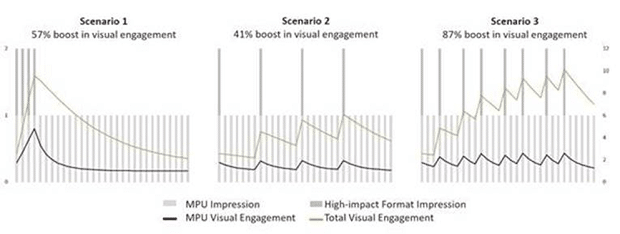
The study from Inskin Media and Lumen Research, showed that seeing a high-impact format can significantly increase the cut through potential, pegged ‘amplification effect’, of standard display advertising, increasing its likelihood of being noticed by 27%, and its visual engagement time by 39%.
Regression models showed that the amplification retention rate was 75% per day, meaning that as time passes, the net attention lift to the standard format caused by the high-impact format will weaken.
Using this data, the strength and longevity of amplification effects can be optimised with intelligent flighting scenarios.
Three different flighting scenarios were modelled during the study, in order to derive recommendations based on campaign criteria such as budget and duration. When campaigns were front-loaded with high-impact formats there was an initial sharp spike in visual engagement time (attention) on subsequent amplified MPUs – it then began to decline slowly (Scenario 1). However, the cumulative boost in visual engagement drove a 57% overall increase in attention for the amplified MPUs, thanks to the “priming” impact of the high-impact formats.
In Scenario 2, the same volume of high-impact formats was served at a regular cadence throughout the month-long campaign. With this approach, attention levels on the amplified MPUs rose immediately following the high-impact format exposure, before fading gradually until the next high-impact format was served. This approach created a series of lower, but steadily increasing attention peaks (Scenario 2), generating an overall attention boost of 41% through the course of the month, and mimicking adstock models familiar to TV planning. From the third week onwards, it also delivered more attention than the front-loaded approach (Scenario 1), suggesting that with longer term campaigns, regular exposure to high impact formats drives more value over time.
Finally, in Scenario 3, the number of high-impact formats used weekly was doubled. The result on attention was similar to Scenario 2, but considerably higher. In fact, it culminated in an 87% boost in overall attention to amplified MPUs.
Dominic Tillson, Head of Insight, Inskin Media, commented: “The results show that for short burst campaigns, front-loading with high-impact ads drives the most amplification of standard ads. For longer-term campaigns, regular exposure to high-impact ads drives more amplification over time and increasing their frequency drives even greater amplification effects.
What this means is that with intelligent planning around the needs of each campaign, media planners can drive greater attention at no extra cost, which in turn increases conversions and brand recall, ultimately benefiting overall brand building and campaign performance.”
